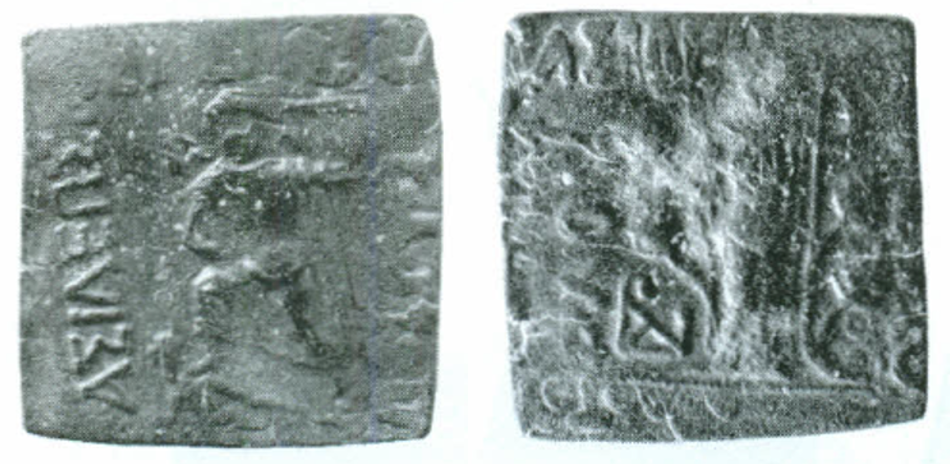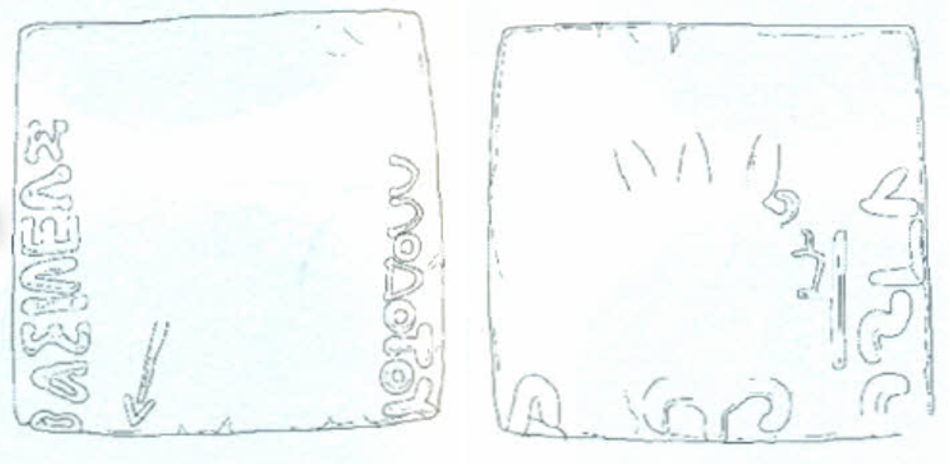58 BCE - 12 BCEΒΑΣΙΛΕΩΣ ΒΑΣΙΛΕΩΝ ΜΕΓΑΛΟΥ ΑΖΟΥ | Maharajasa rajarajasa mahatasa Ayasa (of Great King, King of Kings Azes the Great)
Overstriking coin
SO_2120_-_Gandhara-Punjab_(uncertain_mint)_(Azes_I).png
Overstruck variety
Apollodotus Apollo bow arrow-tripod.jpeg
[1]
2120_Apollodotus_II_Apollo-tripod_(drawing).png
Description
| ObverseInscription or printing placed on the obverse.:
|
ΒΑΣΙΛΕΩΣ ΒΑΣΙΛΕΩΝ ΜΕΓΑΛΟΥ ΑΖΟΥ (Greek) Poseidon standing facing, holding trident, a foot on river-god.
|
ReverseInscription or printing placed on the reverse.:
|
Maharajasa rajarajasa mahatasa Ayasa (of Great King, King of Kings Azes the Great) (Kharoshthi) Yakshi standing facing, holding vines. In left field, monogram.
|
Mint and issuing power
Chronology
| FromIdentifies the initial date in a range assigned in a numismatic context. 58 BCE toIdentifies the final date in a range assigned in a numismatic context.. 12 BCE
|
Hellenistic 323-30 BC  periodTime period of the numismatic object. periodTime period of the numismatic object.
|
Physical description
MetalThe physical material (usually metal) from which an object is made.: Bronze 
|
WeightWeight of the numismatic object (in grams). in grams: 12.4012.4 g <br />12,400 mg <br />
|
DenominationTerm indicating the value of a numismatic object. Examples: tetradrachm, chalkous, denarius.: denomination A
|
|
| DiameterDescribes diameter of an object (in mm).: 2828 mm <br />2.8 cm <br />
|
StandardStandard.: Indian (Hoover)
|
References
| Coin referenceReference of the Coin:
|
Bopearachchi 2008, p. 254, n° 17
|
Coin series referenceReference to coin series study:
|
Mitchiner 19751Mitchiner 1975, p. 492, type 740, Senior 20012Senior 2001, vol. 2, p. 31-32, n° 77, HGC 123HGC 12, n° 674
|
Description
| ObverseInscription or printing placed on the obverse.:
|
ΒΑΣΙΛΕΩΣ ΣΩΤΗΡΩΣ ΑΠΟΛΛΟΔΟΤΟΥ (Greek) Apollo standing facing, holding bow and arrow (visible on reverse: arrow and part of legend)
|
ReverseInscription or printing placed on the reverse.:
|
Maharajasa tratarasa Apaladatasa (of Great King Apollodotus the Savor) (Kharoshthi) Tripod. In left field, monogram. In right field, Kharoshthi letter (visible on obverse: traces of tripod, monogram and part of legend)
|
Mint and issuing power
Chronology
| FromIdentifies the initial date in a range assigned in a numismatic context. 80 BCE toIdentifies the final date in a range assigned in a numismatic context.. 65 BCE
|
Hellenistic 323-30 BC  periodTime period of the numismatic object. periodTime period of the numismatic object.
|
Physical description
| DenominationTerm indicating the value of a numismatic object. Examples: tetradrachm, chalkous, denarius. ᵖ:
|
denomination A
|
StandardStandard. ᵖ:
|
Indian (Hoover)
|
References
 Traces of the overstruck variety
Traces of the overstruck variety

